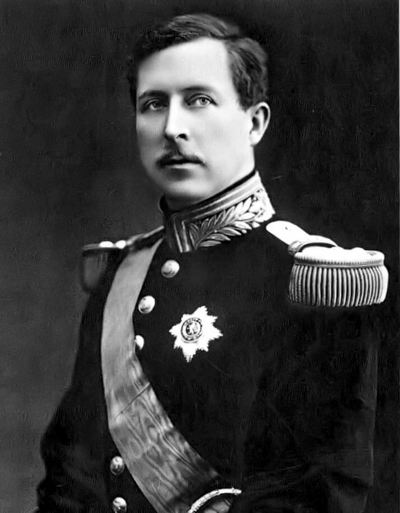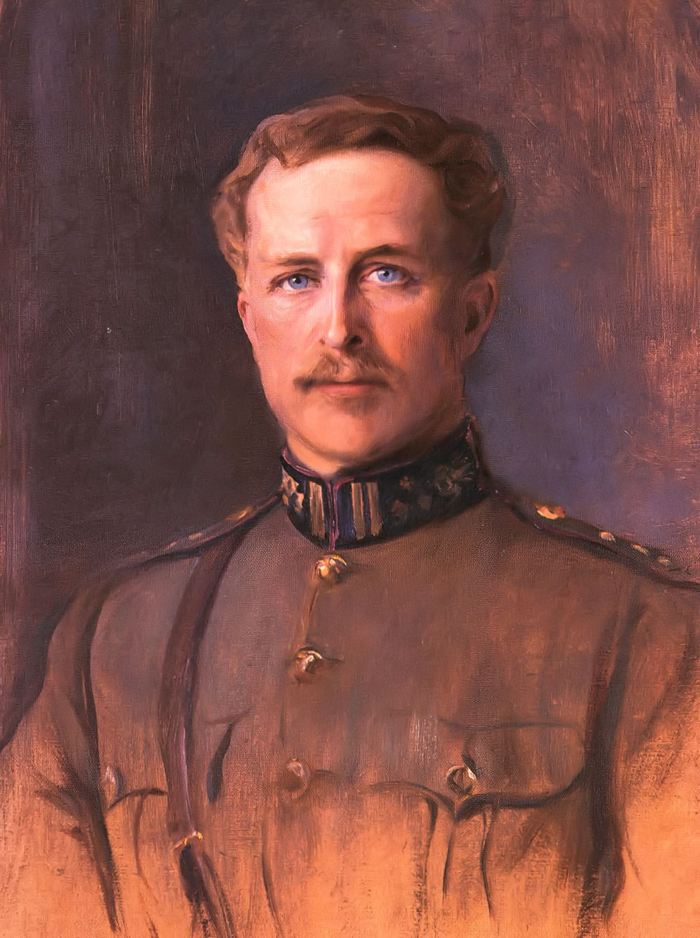Albert I of Belgium (Albert I of Belgium )

Born Albert Léopold Clément Marie Meinrad in Brussels, he was the fifth child and second son of Prince Philippe, Count of Flanders, and his wife, Princess Marie of Hohenzollern-Sigmaringen. Prince Philippe was the third (second surviving) son of Leopold I, the first King of the Belgians, and his wife, Marie-Louise of France, and the younger brother of King Leopold II of Belgium. Princess Marie was a relative of Kaiser Wilhelm II of Germany, and a member of the non-reigning, Catholic branch of the Hohenzollern family. Albert grew up in the Palace of Flanders, initially as third in the line of succession to the Belgian throne as his reigning Uncle Leopold II’s son had already passed away. When, however, Albert’s older brother, Prince Baudouin of Belgium, who had been subsequently prepared for the throne, also died young, Albert, at the age of 16, unexpectedly became second in line (after his father) to the Belgian Crown.
Retiring and studious, Albert prepared himself strenuously for the task of kingship. In his youth, Albert was seriously concerned with the situation of the working classes in Belgium, and personally travelled around working class districts incognito, to observe the living conditions of the people. Shortly before his accession to the throne in 1909, Albert undertook an extensive tour of the Belgian Congo, which had been annexed by Belgium in 1908 (after having been previously owned by King Leopold II of Belgium as his personal property), finding the area in poor condition. Upon his return to Belgium, he recommended reforms to protect the native population and to further technological progress in the colony. He was the 1,152nd Knight of the Order of the Golden Fleece in Austria and the 851st Knight of the Order of the Garter in 1914.
Albert was married in Munich on 2 October 1900 to Duchess Elisabeth Gabrielle Valérie Marie in Bavaria, a Wittelsbach princess whom he had met at a family funeral. A daughter of Karl-Theodor, Duke in Bavaria, and his wife, the Infanta Maria Josepha of Portugal, she was born at Possenhofen Castle, Bavaria, Germany, on 25 July 1876, and died on 23 November 1965. Based on the letters written during their engagement and marriage (cited extensively in the memoirs of their daughter, Marie-José) the young couple appear to have been deeply in love. The letters express a deep mutual affection based on a rare affinity of spirit. They also make clear that Albert and Elisabeth continually supported and encouraged each other in their challenging and difficult roles as king and queen. The spouses shared an intense commitment to their country and family and a keen interest in human progress of all kinds. Together, they cultivated the friendship of prominent scientists, artists, mathematicians, musicians, and philosophers, turning their court at Laeken into a kind of cultural salon.
Following the death of his uncle, Leopold II, Albert succeeded to the Belgian throne in December 1909, since Albert’s own father had already died in 1905. Previous Belgian kings had taken the royal accession oath only in French; Albert innovated by taking it in Dutch as well. He and his wife, Queen Elisabeth, were popular in Belgium due to their simple, unassuming lifestyle and their harmonious family life, which stood in marked contrast to the aloof, autocratic manner and the irregular private life of Leopold II. An important aspect of the early years of Albert’s reign was his institution of many reforms in the administration of the Belgian Congo, Belgium’s only colonial possession.
King Albert was a devout Catholic. Many stories illustrate his deep and tender piety. For instance, when his former tutor General De Grunne, in his old age, entered the Benedictine monastery of Maredsous in Belgium, King Albert wrote a letter to him in which he spoke of the joy of giving oneself to God. He said: “May you spend many years at Maredsous in the supreme comfort of soul that is given, to natures touched by grace, by faith in God’s infinite power and confidence in His goodness”. To another friend, a Chinese diplomat, who became a Catholic monk, Albert wrote: “Consecrating oneself wholly to the service of Our Lord gives, to those touched by grace, the peace of soul which is the supreme happiness here below”. Albert used to tell his children: “As you nourish your body, so you should nourish your soul.” In an interesting meditation on what he viewed as the harm which would result if Christian ideals were abandoned in Belgium, he said: “Every time society has distanced itself from the Gospel, which preached humility, fraternity, and peace, the people have been unhappy, because the pagan civilization of ancient Rome, which they wanted to replace it with, is based only on pride and the abuse of force” (Commemorative speech for the war dead of the Battle of the Yser, given by Dom Marie-Albert, Abbot of Orval Abbey, Belgium, in 1936 ).
Just before World War I, Albert complied with a British demand that he not acquiesce to a German request to move troops through Belgium in order to attack Britain’s ally, France, which Germany anticipated was about to declare war on Germany in support of Russia; Britain was one of several European Great Powers guaranteeing Belgian neutrality under an 1839 treaty. King Albert refused passage of the Kaiser’s soldiers through his nation. When Germany subsequently invaded Belgium, King Albert, as prescribed by the Belgian constitution, took personal command of the Belgian army, and held the Germans off long enough for Britain and France to prepare for the Battle of the Marne (6–9 September 1914). He led his army through the Siege of Antwerp and the Battle of the Yser, when the Belgian army was driven back to a last, tiny strip of Belgian territory, near the North Sea. Here the Belgians, in collaboration with the armies of the Triple Entente, took up a war of position, in the trenches behind the River Yser, remaining there for the next four years. During this period, King Albert fought with his troops and shared their dangers, while his wife, Queen Elisabeth, worked as a nurse at the front. During his time on the front, rumors spread on both sides of the lines that the German soldiers never fired upon him out of respect for him being the highest ranked commander in harm’s way, while others feared risking punishment by the Kaiser himself. The King also allowed his 14-year-old son, Prince Leopold, to enlist in the Belgian army as a private and fight in the ranks.
The war inflicted great suffering on Belgium, which was subjected to a harsh German occupation. The King, fearing the destructive results of the war for Belgium and Europe and appalled by the huge casualty rates, worked through secret diplomatic channels for a negotiated peace between Germany and the Entente based on the “no victors, no vanquished” concept. He considered that such a resolution to the conflict would best protect the interests of Belgium and the future peace and stability of Europe. Since, however, neither Germany nor the Entente were favorable to the idea, tending, instead to seek total victory, Albert’s attempts to further a negotiated peace were unsuccessful. At the end of the war, as commander of the Army Group Flanders, consisting of Belgian, British and French divisions, Albert led the final offensive of the war that liberated occupied Belgium. King Albert, Queen Elisabeth, and their children then re-entered Brussels to a hero’s welcome.
From September 23 through November 13, 1919, King Albert, Queen Elisabeth of Bavaria, and their son Prince Leopold took an official visit to the United States. During a visit of the historic Indian pueblo of Isleta Pueblo, New Mexico, King Albert decorated Father Anton Docher with the Order of Léopold. Docher offered the King a turquoise cross mounted in silver made by the Tiwas Indians. Ten thousand people traveled to Isleta for this occasion. In 1918, King Albert forged a post-war “Government of National Union” made up of members of the three main parties in Belgium, the Catholics, the Liberals, and the Socialists. Albert I remembered the Belgian general strike of 1913, and the promise following that of a Constitutional reform for an actual one man, one vote universal suffrage.
On April 18, 1893, at the end of the Belgian general strike of 1893, universal suffrage, approved by the Belgian Parliament, gave plural votes to individuals based on their wealth, education, and age, but this was clearly not a universal suffrage. Albert attempted to mediate between the parties in favor of universal suffrage and those opposed to it in order to bring about one man, one vote universal suffrage. He succeeded. Some people have named this the “conspiracy of Loppem” because the one man, one vote suffrage was effected without changing the Constitution of Belgium.
The Belgian government sent the King to the Paris Peace Conference in April 1919, where he met with the leaders of France, Britain and the United States. He had four strategic goals: to restore and expand the Belgian economy using cash reparations from Germany; to assure Belgium’s security by the creation of a new buffer state on the left bank of the Rhine; to revise the obsolete treaty of 1839; to promote a ‘rapprochement’ between Belgium and the Grand duchy of Luxemburg. He strongly advised against a harsh, restrictive treaty against Germany to prevent future German aggression. He also considered that the dethronement of the princes of Central Europe and, in particular, the dissolution of the Habsburg Empire would constitute a serious menace to peace and stability on the continent. The Allies considered Belgium to be the chief victim of the war, and it aroused enormous popular sympathy, but the King’s advice played a small role in Paris.
Albert spent much of the remainder of his reign assisting in the post-war reconstruction of Belgium. Albert was a committed conservationist and in 1925, influenced by the ideas of Carl E. Akeley, he founded Africa’s first national park, now known as Virunga National Park, in what is now Democratic Republic of Congo. During this period, he was also the first European monarch to visit the United States.
A passionate alpinist, King Albert I died in a mountaineering accident while climbing alone on the Roche du Vieux Bon Dieu at Marche-les-Dames, in the Ardennes region of Belgium near Namur. His death shocked the world and he was deeply mourned, both in Belgium and abroad. Because King Albert was an expert climber, some questioned the official version of his death. Nonetheless, rumors of murder have been dismissed by most historians. There are two possible explanations for his death: the first was he leaned against a boulder at the top of the mountain which became dislodged; or two, the pinnacle to which his rope was belayed had broken, causing him to fall about sixty feet. King Albert is interred in the Royal Crypt at the Church of Our Lady of Laeken in Brussels.
In 1935, prominent Belgian author Emile Cammaerts published a widely acclaimed biography of King Albert I, titled “Albert of Belgium: Defender of Right.” In 1993, a close climbing companion of the King, Walter Amstutz, founded the King Albert I Memorial Foundation, an association based in Switzerland and dedicated to honoring distinguished individuals in the mountaineering world. Celebrating 175 years of Belgian Dynasty and the 100th anniversary of his accession, Albert I was recently selected as the main motif of a high-value collectors’ coin: the Belgian 12.5 euro Albert I commemorative coin, minted in 2008. The obverse shows a portrait of the King.
Born
- April, 08, 1875
- Brussels, Belgium
Died
- February, 17, 1934
- Namur, Belgium
Cemetery
- Notre Dame Church
- Brussels, Belgium




